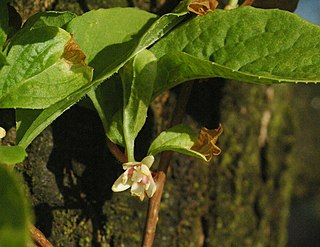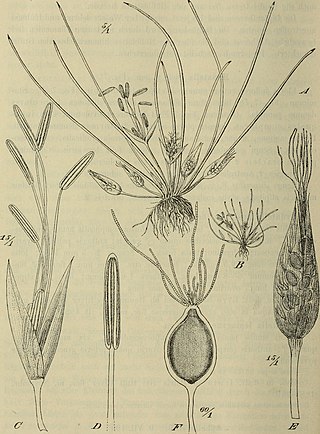
Asterales is an order of dicotyledonous flowering plants that includes the large family Asteraceae known for composite flowers made of florets, and ten families related to the Asteraceae. While asterids in general are characterized by fused petals, composite flowers consisting of many florets create the false appearance of separate petals.

The Solanales are an order of flowering plants, included in the asterid group of dicotyledons. Some older sources used the name Polemoniales for this order.

Musaceae is a family of flowering plants composed of three genera with about 91 known species, placed in the order Zingiberales. The family is native to the tropics of Africa and Asia. The plants have a large herbaceous growth habit with leaves with overlapping basal sheaths that form a pseudostem making some members appear to be woody trees. In most treatments, the family has three genera, Musa, Musella and Ensete. Cultivated bananas are commercially important members of the family, and many others are grown as ornamental plants.

Berberidopsidales is an order of Southern Hemisphere woody flowering plants. The name is newly accepted in the APG III system of plant taxonomy. APG II system, of 2003, mentions the possibility of recognizing the order, as comprising the families Berberidopsidaceae and Aextoxicaceae. However, APG II left the families unplaced as to order, assigning them to the clade core eudicots. The APG III system of 2009 formally recognized the order.

Nartheciaceae is a family of flowering plants. The APG III system places it in the order Dioscoreales, in the clade monocots. As circumscribed by APG IV (2016) it includes 35 species of herbaceous plants in the following five genera:

The Angiosperm Phylogeny Group (APG) is an informal international group of systematic botanists who collaborate to establish a consensus on the taxonomy of flowering plants (angiosperms) that reflects new knowledge about plant relationships discovered through phylogenetic studies.

Schisandraceae is a family of flowering plants with 3 known genera and a total of 92 known species. Such a family has been recognized by most taxonomists, at least for the past several decades. Before that, the plants concerned were assigned to family Magnoliaceae and Illiciaceae.

Chloranthaceae is a family of flowering plants (angiosperms), the only family in the order Chloranthales. It is not closely related to any other family of flowering plants, and is among the early-diverging lineages in the angiosperms. They are woody or weakly woody plants occurring in Southeast Asia, the Pacific, Madagascar, Central and South America, and the West Indies. The family consists of four extant genera, totalling about 77 known species according to Christenhusz and Byng in 2016. Some species are used in traditional medicine. The type genus is Chloranthus. The fossil record of the family, mostly represented by pollen such as Clavatipollenites, extends back to the dawn of the history of flowering plants in the Early Cretaceous, and has been found on all continents.

Trimeniaceae is a family of flowering plants recognized by most taxonomists, at least for the past several decades. It is a small family of one genus, Trimenia, with eight known species of woody plants, bearing essential oils. The family is subtropical to tropical and found in Southeast Asia, eastern Australia and on several Pacific Islands.
Plant taxonomy is the science that finds, identifies, describes, classifies, and names plants. It is one of the main branches of taxonomy.

Hydatellaceae are a family of small, aquatic flowering plants. The family consists of tiny, relatively simple plants occurring in Australasia and India. It was formerly considered to be related to the grasses and sedges, but has been reassigned to the order Nymphaeales as a result of DNA and morphological analyses showing that it represents one of the earliest groups to split off in flowering-plant phylogeny, rather than having a close relationship to monocots, which it bears a superficial resemblance to due to convergent evolution. The family includes only the genus Trithuria, which has at least 13 species, although species diversity in the family has probably been substantially underestimated.
The following outline is provided as an overview of and topical guide to botany:

Kattungal Subramaniam Manilal is an Emeritus of the University of Calicut, a botany scholar and taxonomist, who devoted over 35 years of his life to research, translation and annotation work of the Latin botanical treatise Hortus Malabaricus. This epic effort brought to light the main contents of the book, a wealth of botanical information on Malabar that had largely remained inaccessible to English-speaking scholars, because the entire text was in the Latin language.
The Angiosperm Phylogeny Website is a website dedicated to research on angiosperm phylogeny and taxonomy.

Mesangiospermae is a clade of flowering plants (angiosperms), informally called "mesangiosperms". They are one of two main groups of angiosperms. It is a name created under the rules of the PhyloCode system of phylogenetic nomenclature. There are about 350,000 species of mesangiosperms. The mesangiosperms contain about 99.95% of the flowering plants, assuming that there are about 175 species not in this group and about 350,000 that are. While such a clade with a similar circumscription exists in the APG III system, it was not given a name.

Chrispus Livingstone, often referred as Livi, is an Indian research scientist, botanist, educator and multifaceted person. He was instrumental in upgrading the department of Botany to one of the top three in India. During his stint the department witnessed significant innovative changes in the curriculum with the introduction of new papers and special projects (optionals) at various levels besides high quality research projects carried out by the senior professors and their research scholars leading to several accomplishments. He was also instrumental in setting up India's first artificial horticulture farm. Among his varied interests is the taxonomy of tropical plants, especially flora of Chennai, then Madras. He is perhaps best known for his book The flowering plants of Madras City and its immediate neighbourhood.
Themath Soman Nayar is an Indian Conservation Biologist specialized in plant-animal interaction, angiosperm taxonomy and palynology. He was trained in these fields from Botanical Survey of India, Sardar Patel University and Birbal Sahni Institute of Paleobotany. From 1991 to 2012 he was the Head of the Division of Conservation Biology, Jawaharlal Nehru Tropical Botanic Garden and Research Institute, Thiruvananthapuram.

Mamiyil Sabu formerly Head of the Department of Botany, University of Calicut and currently working as CSIR-Emeritus Scientist at Malabar Botanical Garden and Institute for Plant Sciences, Kozhikode district, Kerala, India. He worked for over 37 years on the research of gingers, which include families such as Cannaceae, Marantaceae, Zingiberaceae, Heliconiaceae, Costaceae, Musaceae etc. A comprehensive work on these groups have been taken after a gap of 125 years, which resulted in the discovery of several new species and rediscovery of many species after 155 years.

Arisaema section Sinarisaema is a section of the genus Arisaema.














